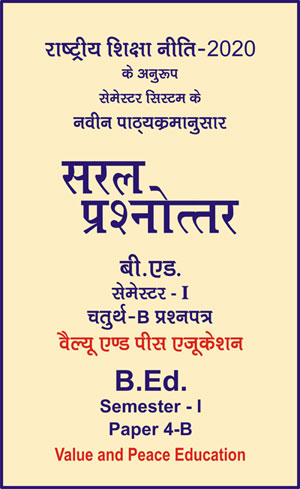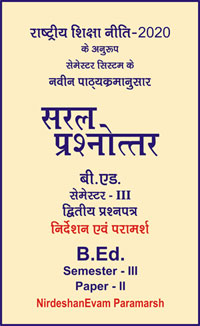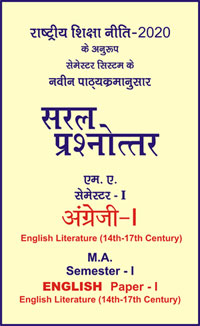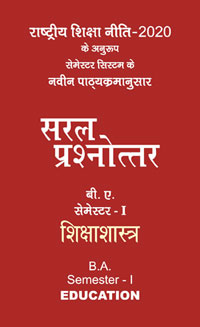|
बी एड - एम एड >> बी.एड. सेमेस्टर-1 प्रश्नपत्र-IV-B - वैल्यू एण्ड पीस एजुकेशन बी.एड. सेमेस्टर-1 प्रश्नपत्र-IV-B - वैल्यू एण्ड पीस एजुकेशनसरल प्रश्नोत्तर समूह
|
|
||||||
बी.एड. सेमेस्टर-1 प्रश्नपत्र-IV-B - वैल्यू एण्ड पीस एजुकेशन (अंग्रेजी भाषा में)
OBJECTIVE TYPE QUESTIONS
For each of the following questions, four alternatives are given for the answer. Only one of them is correct. Choose the correct alternative.
Classification of values
-
Held conceives of feminism as:
(a) a counterproductive way of doing ethical theory.
(b) already present in mainstream philosophical ethics.
(c) providing additional insights that can be incorporated into existing theories.
(d) requiring a radical transformation of existing ethical theories. -
According to Held, nature has traditionally been associated with:
(a) men.
(b) women.
(c) both men and women.
(d) neither men nor women. -
Held claims that traditional moral theory has largely ignored the morally significant relationship of:
(a) friendship.
(b) sibling-hood.
(c) motherhood.
(d) fatherhood. -
Held argues that emotions:
(a) are unimportant to moral theory, and have rightly been largely discounted.
(b) are unimportant to moral theory, and have played too large a role in traditional theories.
(c) are important to moral theory, and have been wrongly discounted.
(d) are important to moral theory, and have rightly been emphasized in traditional theories. -
According to psychologists such as Carol Gilligan, the moral reasoning of women:
(a) is basically the same as the moral reasoning of men.
(b) is more likely to make reference to norms of fairness than that of men.
(c) is more likely to make reference to particular others than that of men.
(d) is more likely to make reference to considerations of happiness than that of men. -
Held argues that the very center of our moral and social thought ought to be concerned with the flourishing of:
(a) men.
(b) women.
(c) children.
(d) minorities. -
Held criticizes the philosophers Heyd and Urmson for conceiving of the sacrifices of mothers as:
(a) ultimately selfish.
(b) supererogatory.
(c) obligatory.
(d) outside the sphere of morality. -
Held claims that the values of “the household”:
(a) should be abandoned in favor of more egalitarian values.
(b) are not moral values, but are nonetheless important.
(c) are genuine moral values.
(d) are only attainable by women. -
The standard moral argument is a mixture of ..........
(a) Statements and queries
(b) Moral and nonmoral statements
(c) Deductive and inductive premises
(d) Questions and answers -
The best approach to identifying implicit premises is to treat moral arguments as ..........
(a) Inductive
(b) Deductive
(c) Nonmoral statements
(d) Theories -
We can evaluate a moral premise by ..........
(a) Trying to think of counterexamples to it
(b) Referring to the nonmoral premise
(c) Evaluating the conclusion
(d) Rewording the nonmoral premise -
The divine command theory is the view that what makes an action right is ..........
(a) That it maximizes overall happiness
(b) That it minimizes overall happiness
(c) That God commands it or wills it
(d) That it maximizes respect for persons -
A moral theory tries to explain ............
(a) A moral agent’s motivations
(b) What society defines as acceptable
(c) What people believe
(d) What makes an action right or what makes a person good. -
Considered moral judgments are ............
(a) Those moral judgments that are endorsed by conscience
(b) Those moral judgments that the majority of people accept
(c) Those moral judgments that we accept after we reason about them carefully
(d) Those moral judgments that we accept because of our upbringing -
The work of building a plausible worldview will always involve ............
(a) Eliminating premises
(b) Eliminating inconsistencies
(c) Tolerating inconsistencies
(d) Rejecting other worldviews -
Subjective relativism implies that each person is ............
(a) Morally responsible
(b) Conscientious
(c) Tolerant
(d) Morally infallible -
Cultural relativism implies that it is impossible to disagree with one’s culture and be ............
(a) Wrong
(b) Right
(c) Fallible
(d) Understood -
A set of beliefs and theories that help us make sense of a wide range of issues in life is known as a ............
(a) Theory
(b) Premise
(c) Morality
(d) Worldview -
Emotivism is the view that moral statements are ............
(a) Relative to cultures
(b) The same as nonmoral statements
(c) Not moral statements at all
(d) A different kind of moral statements -
A statement asserting that an action is right or wrong (moral or immoral) or that something (such as a person or motive) is good or bad is a/an ............
(a) Amoral statement
(b) Moral statement
(c) Nonmoral statement
(d) Motivating statement -
Which among the following dichotomies is used in a discourse on ethics?
(1) Empirical - Normative
(2) Descriptive - Prescriptive
(3) Fact - Value
(4) Profit - Loss Which of the following is correct?
(a) 1 and 3
(b) 1 and 2
(c) 1, 2 and 3
(d) 2, 3 and 4 Correct -
Which of the following assumption about moral behavior is reasonably justified?
(1) Most people will behave morally if the socialization process has successfully inculcated the right values
(2) Some people will behave more morally than others even if they have been under the same socialization process
(3) Social situations provide the best stimulus to moral action or inaction; i.e., social pressure determines moral action/inaction.
(4) Socialisation has no role in developing moral values
(a) 1 and 4
(b) 1, 2 and 3
(c) 1, 2, 3 and 4
(d) 2 and 3 -
According to most definitions, which of the following does a country definitely need to have in order to be a democracy?
(a) Strategic voting
(b) Recall referenda
(c) Citizen assemblies
(d) Periodic elections -
Which of the following countries has pioneered experiments with direct democracy at the local level through participatory budgeting?
(a) Myanmar
(b) Brazil
(c) Sweden
(d) United States -
Which of the following is typically considered part of procedural definitions of democracy?
(a) Incomes must be equal
(b) All national budgets subject to referenda
(c) Religion must be kept entirely out of politics
(d) Multiple competitors must be allowed -
Which of the following characteristics would scholars like Philippe Schmitter and Terry Karl argue invalidate a country’s claim to full democratic status?
(a) Oil dependence
(b) Presidentialism
(c) Poor economic performance
(d) The military’s de facto veto power over national elections -
Which of the following claims about the relationship between democratic transitions and democratic consolidation is probably wrong?
(a) Democratic transitions don’t matter: Consolidation is the key.
(b) Democratic consolidation doesn’t matter: Transitions are the key.
(c) Neither a nor b matters: Preventing democratic breakdowns is the key.
(d) All of the above -
Modernization theory says that economic development predicts democratic status yet India is relatively poor and a democracy. What does this mean?
(a) India must not really be a democracy.
(b) Modernization theory should be abandoned
(c) India is a textbook case of modernization theory, confirming the theory.
(d) Proponents of modernization theory should clarify how and how frequently they think development and democracy are related. -
Which of the following contemporary states witnessed a gradual process of democratization and democratic consolidation over centuries?
(a) Ottoman Empire
(b) Myanmar
(c) China
(d) The United Kingdom -
What do political scientists tend to think about the role of individual leaders in democratization?
(a) Leadership makes no difference.
(b) Leadership is the main thing that matters.
(c) Leadership matters, but only because it is leaders who design institutions.
(d) Leaders sometimes matter, but they act against the backdrop of structural conditions. -
Which of the following claims about the causes of democratization are supported by some social scientists?
(a) Democratization and democratic consolidation depend heavily on the existence of a strong middle class.
(b) The key to understanding democratization is to trace the long-run development of democracy’s underlying institutions.
(c) Different types of variables might interact so as to produce democratization.
(d) All of the above -
According to most political scientists, which of the following polities is a democracy?
(a) India
(b) Iran
(c) China
(d) Russia -
Which of the following is the closest equivalent to "procedural definition of democracy"?
(a) Substantive definition of democracy
(b) Minimal definition of democracy
(c) Representative definition of democracy
(d) Direct definition of democracy -
Are any of the following key ideas in the modernization theory of democratization?
(a) Institutional design matters more than other factors.
(b) Economic development favors democracy.
(c) Both a and b
(d) Neither a nor b -
Which of the following ideas best describes cultural theories of democratization?
(a) Culture is bad for democracy.
(b) Culture, values, and beliefs exist in inverse proportion to the degree of democracy.
(c) Some cultural traditions, beliefs, attitudes, and values might encourage democracy more than others.
(d) Only democracy depends on culture, whereas other regime types are anti-cultural. -
Which of the following ideas best describes systemic and global approaches to the study of democracy and democratization?
(a) Waves of democratization can be explained entirely on the basis of domestic political structures.
(b) Democracy cannot be a system or a structure.
(c) Waves of democratization respond not just to domestic factors but also to international patterns.
(d) None of these are key ideas -
What is a main reason for conducting within-case analysis?
(a) The analyst wishes to trace causal processes over time.
(b) Some cases are so fascinating that you do not really want to explore others.
(c) Some cases are just really worth researching.
(d) This is a technique for the physical sciences, inappropriate for comparative politics. -
Primary groups are also called :
(a) Face-to-Face groups
(b) Derivative groups
(c) Self-help groups
(d) None of the above -
An example of primary groups is :
(a) an association of workers
(b) Red Cross society
(c) a political party
(d) family -
One of the chief characteristics of secondary group is :
(a) physical proximity
(b) permanency
(c) temporary membership
(d) compulsory membership -
“Spirituality” refers to :
(a) the religion that one adopts as their own.
(b) a god.
(c) that unsatisfiable, deepest desire within everyone, and the ways individuals deal with that desire.
(d) the search for significance, through the sacred, within the context of a shared belief system. -
The capacity to recognize situations and circumstances which have implications for the welfare or well being of another is referred to as :
(a) spirituality.
(b) multicultural dimension.
(c) relational dimension.
(d) ethical sensitivity. -
Which of the following is not a suggested consideration in ethical analysis and resolution?
(a) Determine the culturally significant theoretical perspective
(b) Use relational methods to reach an agreement on potential courses of action.
(c) Determine the key participants involved, based on the cultural values of the client.
(d) Collect relevant cultural information. -
Which of the following is not a spiritual or religious competency involving the client?
(a) Refer to minister, chaplain, rabbi, or other spiritual leader when indicated.
(b) Assess the truthfulness of the client’s spiritual claims.
(c) Seek consultation and/or further education when indicated.
(d) Acquire knowledge to better understand client’s spiritual worldview. -
The relational dimension involves :
(a) how well the counselor can relate to the client.
(b) the capacity for trust, mutuality, ethical sensitivity, and acceptance of uniqueness.
(c) the relationship between the counselor and his or her advisor.
(d) the study of the client’s family and family dynamics. -
Which of the following does not pertain to intellectual development aim of education?
(a) Spiritual development
(b) Cultivation of intelligence
(c) Training and “formation” of mind
(d) Development of cognitive powers -
Preparing the child for future life as an aim of education is preparing child for :
(a) Some suitable vocation
(b) A happy married life
(c) Some particular course of study
(d) Facing all kinds of emergencies and situations of future life -
The most effective method of character-formation is:
(a) Teaching by high character teachers
(b) Teaching virtues through religious books
(c) Organizing specialists’ lectures on importance of values in life
(d) Rewarding virtuous behaviours and presenting high character models in the schools -
Harmonious development of the child aim of education means:
(a) The state is above the individual citizen
(b) The state is an idealized metaphysical entity
(c) The state has to give not to take anything from the individual
(d) The state is superior to the individual transcending all his desires and aspirations -
Rigid system of state-education is justified on the basis that the state:
(a) Has better resources to manage education
(b) Is supreme to dictate what shall be taught and how shall be taught
(c) Has absolute control over the lives, and destinies of its individual members
(d) Has a right and a bounden duty to mould the citizen to a pattern which makes for its own preservation and enhancement -
Social aims of education imply the training of:
(a) Individuals according to their needs
(b) The individuals according to the facilities
(c) The individuals according to their capacities
(d) The individuals for the purpose of serving the needs of the society -
What does the individual aim of education imply?
(a) It should have more and more institutions every year
(b) It should be by and large the concern of the private sector
(c) It must contribute to the peace and happiness of the whole society
(d) Education must secure for everyone the conditions under which the individuality is most completely developed -
According to which philosophy of education, childhood is something desirable for its own sake and children should be children?
(a) Realism
(b) Idealism
(c) Naturalism
(d) Pragmatism -
Who emphasized that education should be a social process?
(a) Dewey
(b) Rousseau
(c) Pestalozzi
(d) Vivekananda -
The social aims of education imply that:
(a) The state is above the individual citizen
(b) The state is an idealized metaphysical entity
(c) The state has to give not to take anything from the individual
(d) The state is superior to the individual transcending all his desires and aspirations -
Religious education is strongly advocated by :
(a) Realist
(b) Idealists
(c) Pragmatists
(d) Existentialists -
Characteristic of Secondary Group is :
(a) Physical proximity
(b) Permanency
(c) Largeness in size
(d) Compulsory membership -
Language, custom, values, traditions are examples of :
(a) Material Culture
(b) Non-material Culture
(c) Intellectual Culture
(d) Industrial Culture -
‘Special interest groups’ are also known as :
(a) Primary groups
(b) Secondary groups
(c) Social groups
(d) Cultural groups
|
|||||

 i
i 









